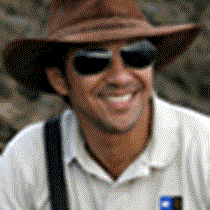Southern Isabela Island
I almost started this report with the typical phrase “what a great day we just had.” Even though it is true, I am very reluctant to tell people something that it is so obvious! To begin with, there is no way that we could have a bad day in the Galápagos; simply because such a thing doesn’t exist!
Our days - not only today - usually start with beautiful sunrises. To some of you (the regular avid readers of our Galápagos daily reports) this is not something unusual. The phrase “beautiful sunrise” doesn’t fully justify what we see during the mornings in the Galápagos, and to describe it better, one should be able to translate scenery into poetry, as that is purely what we see everyday in this islands.
Our day at the island of Isabela was the perfect combination of history, natural cataclysmic events and science. The sights of coral and a whole array of organisms that once upon a time were underwater, grabbed immediately the attention of our guests from the Institute for Ecosystem Studies (IES) traveling with us during this very special week. Urbina Bay is the result of an underwater uplift that brought up to the surface shells and large pieces of coral, back in 1954. Our walk took us not only along the coastline, but to the very interior of the island itself, where a great deal of organisms such as land iguanas and tortoises, inhabit.
One of the most remarkable features of this archipelago is the fact that every single island is very different from the one visited before, and even today, visiting two different areas of the same island, it looks like a completely different world!
The afternoon contrasted with our morning visit due its barren lava flows and hidden brackish water lagoons. It gave us the appreciation of how interesting and unique this ecosystem really is. Flamingoes, white cheeked pintail ducks and other shore birds were found looking very comfortable in this relatively new ecological niche.
To finish our day, a sunset that melted with the Pacific Ocean gave place to a dark and peaceful night full of stars, worth to be part of somebody’s poem.
I almost started this report with the typical phrase “what a great day we just had.” Even though it is true, I am very reluctant to tell people something that it is so obvious! To begin with, there is no way that we could have a bad day in the Galápagos; simply because such a thing doesn’t exist!
Our days - not only today - usually start with beautiful sunrises. To some of you (the regular avid readers of our Galápagos daily reports) this is not something unusual. The phrase “beautiful sunrise” doesn’t fully justify what we see during the mornings in the Galápagos, and to describe it better, one should be able to translate scenery into poetry, as that is purely what we see everyday in this islands.
Our day at the island of Isabela was the perfect combination of history, natural cataclysmic events and science. The sights of coral and a whole array of organisms that once upon a time were underwater, grabbed immediately the attention of our guests from the Institute for Ecosystem Studies (IES) traveling with us during this very special week. Urbina Bay is the result of an underwater uplift that brought up to the surface shells and large pieces of coral, back in 1954. Our walk took us not only along the coastline, but to the very interior of the island itself, where a great deal of organisms such as land iguanas and tortoises, inhabit.
One of the most remarkable features of this archipelago is the fact that every single island is very different from the one visited before, and even today, visiting two different areas of the same island, it looks like a completely different world!
The afternoon contrasted with our morning visit due its barren lava flows and hidden brackish water lagoons. It gave us the appreciation of how interesting and unique this ecosystem really is. Flamingoes, white cheeked pintail ducks and other shore birds were found looking very comfortable in this relatively new ecological niche.
To finish our day, a sunset that melted with the Pacific Ocean gave place to a dark and peaceful night full of stars, worth to be part of somebody’s poem.



